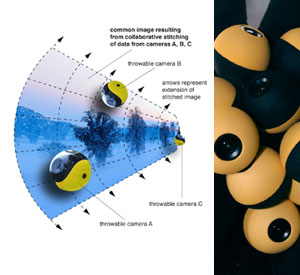 |
2016 UPDATE: (Boston, MA — April 11, 2016) Serveball Labs today announced development of Scattershot360™ collaborative stitching technology, an ongoing R&D project the company anticipates presenting a disruptive challenge to increasingly regulated drone, UAS and UAV sectors. The company’s breakthrough, in which a common microprocessor stitches images arriving wirelessly from multiple thrown or projected cameras, is disclosed in three newly issued U.S. Patents, 9,144,714 (issued 09/2015), 9,219,848 (issued 12/2015) and 9,237,317 (issued 01/2016). The three new patents fortify Serveball Lab’s pre-existing IP portfolio. “Images stitched together from throwable cameras moving in independent trajectories reveal surprisingly interesting relationships,” stated Serveball Labs founder Steve Hollinger. “With Scattershot360, an entire environment is imaged, not from the birds-eye view of one panoramic camera, but from a collective view as seen by a scattered flock — networked cameras pitched airborne, aground, afloat and submerged.” In an example future application of Scattershot360 technology, hundreds of pellet-sized cameras are disbursed over a forest fire during a search-and-rescue operation. Penetrating the forest canopy, the cameras transmit images along with respective location and orientation data, collaborating together in real time to produce a unified image map of the entire forest from treetops to floor. Such an application would be impractical for UAVs and other solutions reliant on self-propulsion for access. Additional applications for Scattershot360 include events requiring rapid, automated collection and remote viewing of image information over a large area; inspections of structures having surfaces visible from two or more perspectives; and in the simultaneous localization and mapping (SLAM) of challenging and/or otherwise inaccessible environments, from outer space to deep oceans. In parallel with development of Scattershot360, Serveball Labs continues development of “Squito,” an intelligent throwable camera capable of capturing and transmitting spherical panoramic images and stabilized 360° video. Squito’s production timeline is aligned with the anticipated availability of consumer-priced microelectronics including location, position, and orientation sensors as well as high-speed image sensors necessary for in-flight capture. Since announcing the Squito project, Serveball Labs has refined its throwable camera prototypes based on analysis of aerodynamic forces acting on camera housings. This effort led to another recently patented breakthrough for Serveball Labs in which an oblate spheroid shaped camera captures images as it rotates about its minor axis. Related innovations include cameras that generate lift to remain aloft for an extended duration; cameras capable of being thrown or projected significantly farther than the bluff body shape of those having a spherical housing; and cameras capable of altering their own trajectory. “We’re beginning to see throwable cameras entering this fledgling market, from omnidirectional baby monitors transmitting 360° video upon landing to panoramic cameras capable of being gently tossed skyward,” Hollinger stated. “While early entrants garner significant attention, the devices themselves remain limited to capturing data while at a still point. Serveball Labs is on track to provide next-generation technology with a far greater degree of practical usefulness.”
Serveball, Squito and Scattershot360 are trademarks of Serveball Labs. Serveball U.S. Patents #8237787, #8477184, #9144714, #9219848, #9237317, #D745,910, #D690,344 and patents pending. |
